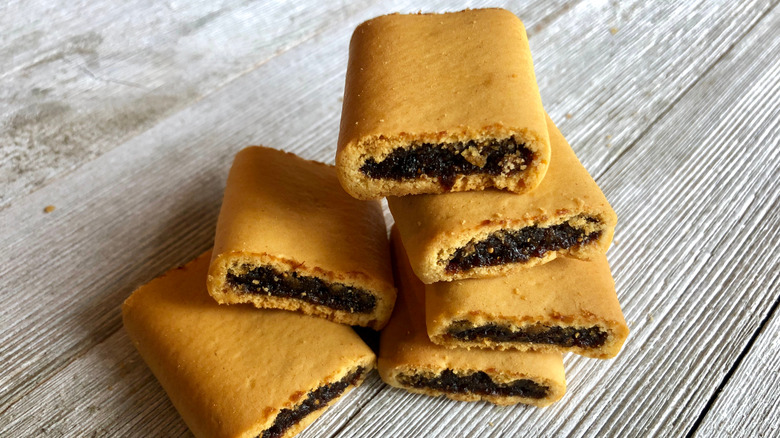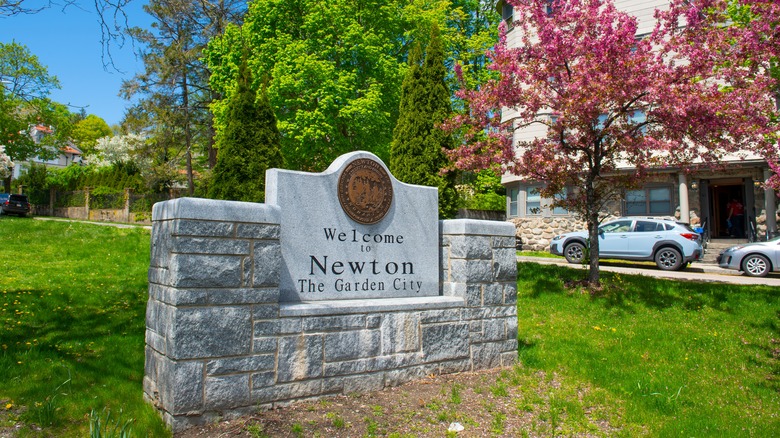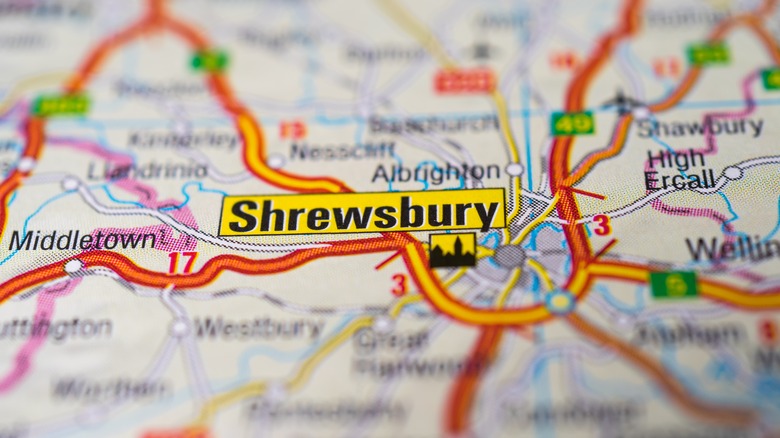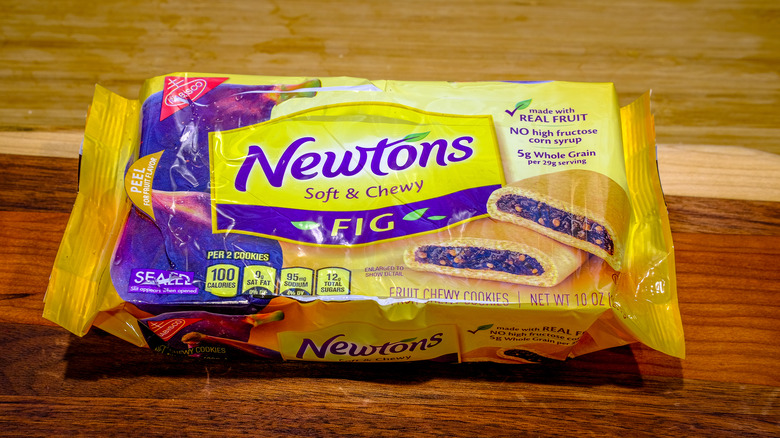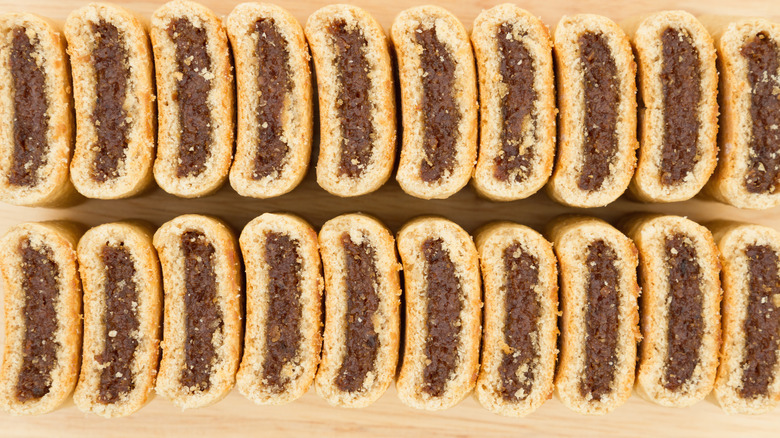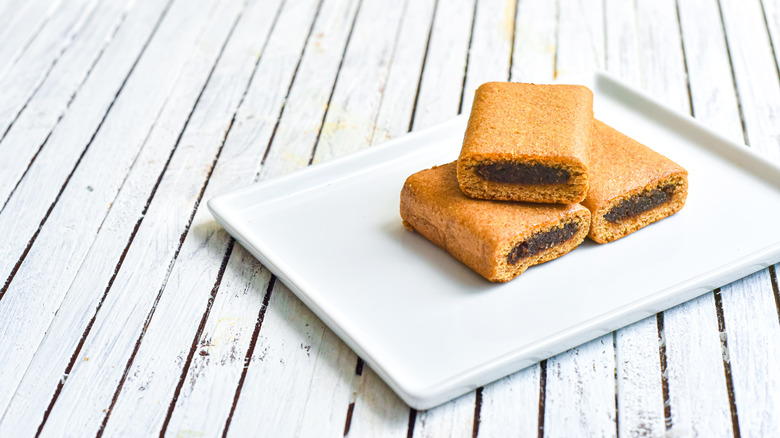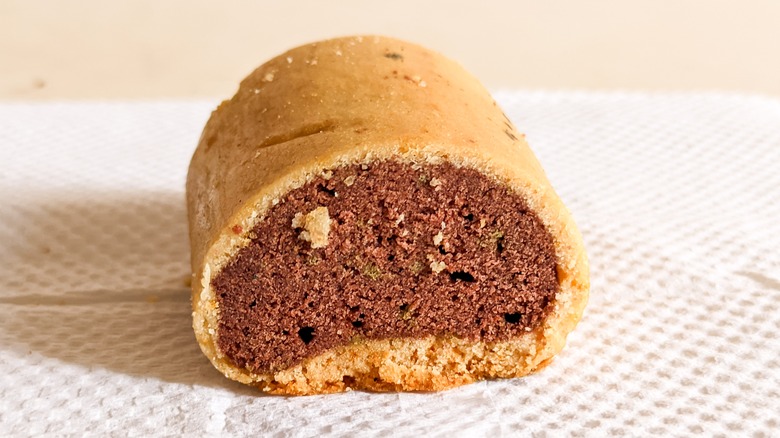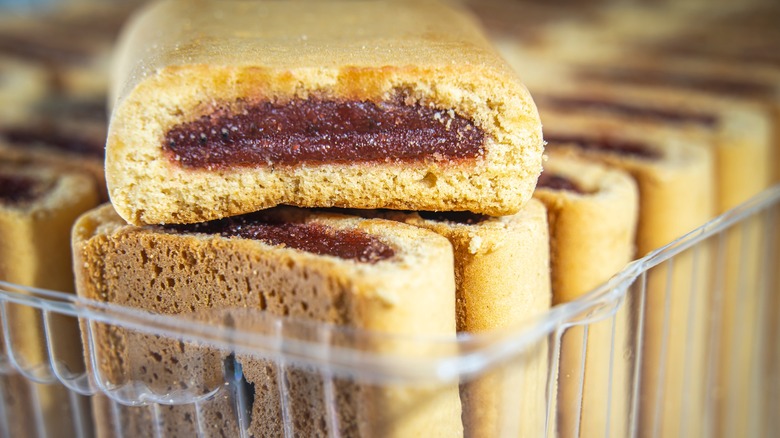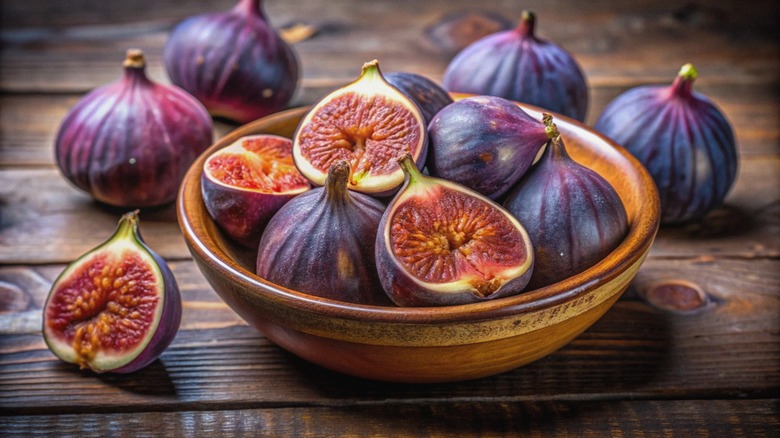The Hidden Story Behind Fig Newtons
Nearly everyone has had a Fig Newton. What's not to love about these soft cookies with their slightly sweet, figgy center? However, if you think about it, these are a bit of a strange cookie. They're not round like most other varieties. Plus, instead of having a consistent texture and taste throughout, they have more of a layered design. Whatever your thoughts about their taste and texture, how much do you really know about Fig Newtons?
Today, Fig Newtons come in a few different flavors. However, that wasn't always the case. The history of this soft and almost cake-like cookie traces back more than 100 years. At that time, there was only one flavor option. Plus, the idea for these treats was based on a recipe that traces back even further in history. Have you ever wondered who came up with the idea to stuff figs — which aren't exactly considered a dessert food — inside a cookie? Or, perhaps you've been curious about what a Newton is and why that name was selected for this particular dessert food. Well, we've also been pondering these questions, along with many others, and decided to do a deep dive into the world of Fig Newtons and get some answers. Keep reading to discover the hidden story behind Fig Newtons.
Fig Newtons are not named after Sir Isaac Newton
Rumors and myths seem to circulate as if they are hard facts. And many of our favorite foods are not exempt from being caught up in these rumors. Just think about the number of myths about SPAM. Well, there are also some rumors circulating about Fig Newtons. One of the most prevalent is that the cookies were named after Sir Isaac Newton. If you've believed this, it is understandable. You don't hear the word Newton too much, except when it refers to the famous scientist.
However, it doesn't make sense if you take a second to think about it. The genius scientist observed an apple — not a fig — falling from a tree, prompting his discovery of gravity. In reality, Fig Newtons got their name from Newton, Massachusetts. Charles M. Roser is credited with inventing the treat. He sold his creation to Kennedy Biscuit Works, which produced the first packs of the new cookie. Kennedy Biscuit Works, a Massachusetts-based company, had a habit of naming its goods after cities in the state. The town of Newton was the lucky winner of this concoction. In fact, the cookies were originally called Newtons, the word "fig" was added to the name later.
The cookie was almost called the Fig Shrewsbury
There is a bit of a debate about this one, but some sources indicate that Fig Newtons were almost given a different name. Remember, Kennedy Biscuit Works, the company that originally produced the treats, had a habit of naming their cookies after towns in Massachusetts. The factory in Massachusetts was close to Shrewsbury, which some say almost won out as the name before Newton was finalized as the best choice. However, Newton won out, possibly because some considered it a more sophisticated or elegant choice.
However, as mentioned, there is a bit of a debate. Other sources indicate that Kennedy Biscuit Works had already named another cookie after Shrewsbury, Massachusetts. While we might not know the whole story, it is safe to say that Fig Newton was the right choice. Fig Shrewsbury just doesn't have the same ring to it — sort of like calling a hot dog a glizzy. Who knows, if the cookies had been called that, they may not have gained the same following that they did, and many of us may never have even heard of them.
They're not called Fig Newtons anymore
After all this debate about how these cookies came to be called Fig Newtons, you're making a mistake if you're still referring to them as Fig Newtons. More than a decade ago — in 2012 — Nabisco rebranded the cookies. Similar to how Campbell's took "Soup" out of its name, Nabisco dropped the "Fig" from "Fig Newtons." They're now simply called Newtons. Don't believe us? Walk down the cookie aisle and see for yourself. Trust us, we were just as shocked to learn this.
So, why the change? A few potential reasons are floating around. One is that the manufacturer was striving to appeal to younger shoppers who may not have viewed figs as very exciting or something that belongs in a cookie. Another potential reason for the change is that the cookies weren't only available with a fig filling anymore. Nabisco started offering different flavor options, including strawberry. It doesn't make sense to call a cookie with a strawberry filling a "fig".
Fig Newtons were almost the Massachusetts state cookie
If you've traveled around the United States, you've probably realized how each state is very proud of its heritage, special landmarks, events, and, yes, even food items connected with it. You'll find references to state flowers, state birds, or even special treats at the state fair, such as fried alligator at the Illinois State Fair. And let's not forget about state cookies.
Given that Fig Newtons were developed in Massachusetts, you'd think it would be a shoo-in for the state cookie. In 1997, William Weld, the governor of Massachusetts, felt strongly that the cookies should indeed be chosen. He not only understood the cookie's history and its origins but is also reported to have been a big fan of Fig Newtons.
However, the Fig Newton didn't win out. Instead, the chocolate chip cookie was selected as the state's cookie. Those sweet treats were also developed in Massachusetts by Ruth Wakefield at the Toll House Inn. Ultimately, one of the voices that helped persuade Governor Weld to end his campaign for the Fig Newton came from a third-grader. That child is reported to have said, "When was the last time your mother baked you a warm batch of Fig Newtons?" and helped Weld see why the chocolate chip cookie was the best choice.
Fig Newtons' mass production was due to a revolutionary invention
Fig Newtons were invented towards the end of the 19th century — more than 100 years ago. Today, mass production is commonplace and something we take for granted. But, back then, it was less common, especially for something as involved as Fig Newtons. Think about it. Unlike more traditional, round cookies that need to be scooped and baked in an oven, Fig Newtons have a layered design, necessitating filling the center with fig jam. That was not such a simple feat towards the end of the 1800s.
Fortunately for those who love Fig Newtons, James Henry Mitchell invented a machine that would allow the cookies to be mass-produced. His invention featured two funnel-like components that worked together. The inner funnel released the jam filling into the middle of the dough that was released through the outer funnel. This process yielded a long cookie that was cut into sections to create smaller cookies to package and sell. Mitchell invented this Fig Newton maker in 1891.
Fig Newtons used to have a different shape
One of the things that makes Fig Newtons so unique is their shape. While most other products on the market are nearly cookie-cutter (pun intended) images of one another with a perfectly round shape, Fig Newtons stand out from the crowd. They have an oblong shape — much closer to a rectangle than a circle. The corners are rounded to smooth things out, but there is no mistaking them for a circle.
However, what we all know as the classic Fig Newtons shape isn't how the cookies started. While they weren't round like other products on the market, they were closer to a square than a rectangle. One reason the cookies were never round probably relates to the extrusion machine used to mass-produce them. If you'll remember, once the two funnels worked together to create the top and bottom layer of the cakey cookie with a fig filling, the resulting production was one long, rectangular treat. This was cut into squares — or, more recently, rectangles. But cutting several circles from such a shape wouldn't be practical and would result in a lot of wasted yumminess.
Fig Newtons were a new take on an old recipe
While Charles M. Roser is generally credited with inventing the Fig Newton, he wasn't the first to add fig between layers of a soft pastry. It is likely that Roser, who was a cookie maker, got the idea from something called a fig roll. Fig rolls were a special type of cookie that featured a scoop of fig (with a smoother, jam-like consistency) surrounded by a crumbly cookie/biscuit-like exterior. The recipe was introduced in the United States by immigrants from Britain.
There doesn't appear to be any records from Roser citing the fig roll as the inspiration for his Fig Newton. But it is a logical conclusion to think that he did use the older recipe as a starting point for his creation.
However, the full history of similar figgy treats traces farther back in history than Roser, or even the British immigrants. Medieval Muslims are credited with adding sugar to dough to create biscuits, which were viewed as a health food. In fact, an Arab physician from the time, Ibn Butlan, advised patients to fill biscuits with figs and nuts to maximize the health benefits they would receive.
Fig Newtons aren't called cookies everywhere
If you call Fig Newtons cookies, you're certainly not alone. However, you're also not in agreement with all other consumers. Let's start here in the United States. You might be surprised to hear that Fig Newtons haven't always been referred to as cookies here. In fact, up until the late 1980s, they were referred to as cakes. Similar to using cake flour to make cookies, these treats have a softer and more cake-like texture. So, it isn't too much of a stretch to understand why they were called cakes for almost 100 years.
Even today, Fig Newtons aren't called cookies everywhere. One example is in the U.K., where many refer to them as biscuits. If you're thinking there's no way this cookie could pass as a biscuit — such as you'd eat on the side of an order of fried chicken — don't worry, the meaning of biscuit is synonymous with "cookie" in the U.K.
Fig Newtons were not always made by Nabisco
While you may associate Fig Newtons with Nabisco, this large manufacturer wasn't always listed as the owner of the cookie. Charles M. Roser, the creator of the figgy cookie, sold his recipe to Kennedy Biscuit Works in 1891. However, just eight years after the Kennedy Biscuit Company was bought out by William Moore. In addition to the Kennedy Biscuit Company, Moore also purchased about seven other bakeries. He named his new company the New York Biscuit Company. Around the same time, Moore bought multiple bakeries, and another investor, Adolphus Green, merged 40 bakeries across the Midwest to form the American Biscuit Company.
A few years later, Moore and Green merged their two companies, naming the new company the National Biscuit Company, or N.B.C. The term "Nabisco" was first used in 1901 for one of the company's sugar wafers. 70 years later, in 1971, Nabisco officially became the company's corporate name. In 2000, Nabisco was acquired by Philip Morris Companies and merged with Kraft Foods. Today, Nabisco's cookies, biscuits, and other snack foods fall under the Mondelēz International manufacturing umbrella.
Fig Newtons were the third-most popular cookie in the U.S.
Regardless of your feelings about Fig Newtons compared to other cookie types in the grocery store, they were actually one of the top sellers. In 1992, Fig Newtons were ranked as the third-most popular cookie in the United States. Only Oreos and Chips Ahoys were more popular.
There are a few different factors that worked together to drive sales. First, Nabisco's marketing for the treat changed in the '80s, making them sound more exciting to potential consumers. Nabisco used to refer to Fig Newtons as "cakes." However, in the 1980s, the company shifted its advertising strategy, calling them a "chewy cookie." They launched new ad campaigns and commercials that stated, "A cookie is just a cookie, but Newtons are fruit and cake" (via YouTube ). Then, in 1992, Nabisco started offering fat-free Fig Newtons. These factors and other smart marketing decisions led more consumers to purchase the cookie and helped to drive sales.
Fig Newtons were viewed as a health food
If you've ever tasted a Fig Newton, then you know they are sweet and cakey. Definitely a dessert. However, throughout the cookie's over 100-year history, it has often been viewed and promoted as a healthy food, and there are a couple of reasons for this. Just as honey was used for medicinal purposes long ago, figs were also seen as a healthy option. And there is a lot of truth to that. Figs offer essential vitamins and nutrients like magnesium and potassium and may offer digestive health benefits because of their fiber content. Moreover, eating figs may support a healthier vascular system with a lowered risk of heart disease. However, this is for figs themselves — not sweet cookies made using some fig that could cancel out or minimize some of these benefits with their sugar content.
Still, this didn't stop Nabisco from leaning into the health benefits of figs when advertising these cookies. The manufacturer emphasized the higher levels of fiber the cookie offered and even aired ads featuring athletes to promote the treat as a healthier option. However, while Fig Newtons might be slightly healthier than some other cookies, don't be fooled into thinking they are healthy food. As with other sweet treats, you'll want to eat them in moderation and as part of a healthy diet.
Newton, Massachusetts held a celebration for the cookie's 100-year anniversary
Fig Newtons hold a special place in the hearts of many people in Massachusetts, particularly those in Newton, the cookie's namesake. In 1991, for the cookie's 100th anniversary, the town of Newton held a big celebration in honor of the sweet and figgy treat. The celebration was a big deal, with some special guest stars.
Juice Newton — a popular singer from the 1980s – made an appearance. Any guesses as to why Ms. NEWTON was chosen for this event? Big Fig – a large, dancing "Fig" who was featured in commercials years before — also showed up to take part in the celebrations. The 100th anniversary also featured a large barbecue for the town's people to enjoy. Nabisco also donated 25 fig trees to the town of Newton to commemorate the event.
